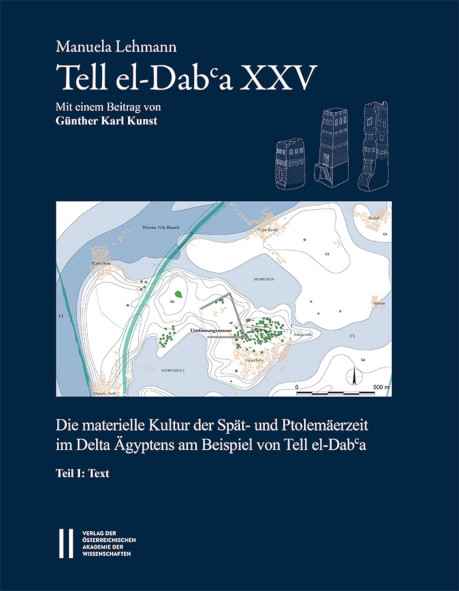
Die materielle Kultur der Spät- und Ptolemäerzeit im Delta Ägyptens am Beispiel von Tell el-Dabʿa. (Tell el-Dabʿa XXV), pp. XV-XVIII, 2021/01/18
mit einem Beitrag von Günther Karl Kunst
Tell el-Dab‘a wurde durch seine Identifizierung mit Avaris, Hauptstadt der Hyksos und später Teil der Ramsesstadt ein bedeutender archäologischer Fundplatz. Nach Versandung des Pelusischen Nilarms am Ende der Ramessidenzeit verschwindet diese Stadt aus der Weltgeschichte. Bisher weitgehend unbekannt ist, dass die Aktivierung des Pelusischen Nilarms in der Spätzeit an diesem strategischen Ort erneut eine große Siedlung von über 100 ha entstehen ließ, die ab dem 7. Jh. v. Chr. den Einfluss der ostmediterranen und antiken Welt auf Ägypten in dieser Zeit widerspiegelt. Auf Basis der Ausgrabungen von 1966-2014 bietet diese Publikation zum ersten Mal einen tiefen Einblick in die Kultur des späten Ägyptens im Nildelta. Die Hausarchitektur dieser Zeit ist vor allem in Überresten von Turmhäusern vertreten, die eingehend anhand von Parallelen in Ägypten besprochen werden. Magnetometer-Surveys zeigen die ausgegrabenen Häuser im Kontext von ca. 50 weiteren solchen Gebäuden und einem Tempel, die sich entlang einer alten Prozessionsstraße, welche zum Tempel des Sutech von Avaris führten, häufen. Neben dem Charakter der Siedlung werden detailliert große Fundzusammenhänge publiziert, die die weitreichenden Handelsbeziehungen mit der griechischen und der phönizischen Welt aufzeigen. Um den Leser in die Atmosphäre einer solchen Stadt einzuführen, wurde ein Exkurs über die heutigen Turmhäuser im Jemen und in Ägypten angefügt. Insgesamt vermittelt diese Publikation einen ganzheitlichen Einblick in die Kultur der Spät- und Ptolemäerzeit Unterägyptens. Sie ist eine wertvolle Grundlage für den Kulturhistoriker und eine bedeutende Bereicherung für die Siedlungsgeschichte des östlichen Nildeltas.
…
Tell el-Dab’a gained importance by its identification with Avaris, capital of the Hyksos and the Delta residence of the Ramessides. After the silting up of the Pelusiac Nile branch at the end of the Ramesside Period this important town was abandoned and disappeared from world history. Largely unknown is the fact that after the re-activation of the Pelusiac branch in the Late Period a large town of over 100 ha developed at this strategically important place. This settlement mirrors the re-colonization of the eastern Delta from the 7th cent. BC onwards. Based on excavations from 1966 until 2014 this publication presents for the first time a detailed insight of the culture of Late Egypt and the eastern Mediterranean world. The domestic architecture of this period is represented with remains of tower-houses which are discussed in detail with parallels in Egypt at that time. Magnetometer surveys show the excavated houses in context of c. 50 remains of this prototype including a Late Period temple which cluster along an old processional road leading to the former temple of Sutekh of Avaris. Besides the character of the settlement and its Nilotic environment the whole array of material culture is published in detail. It shows the far-reaching trade connections with the Greek and Phoenician world. In order to re-create the atmosphere of such a town, an excursus draws attention to modern close parallels of the tower houses in Yemen and in Egypt. Tell el-Dab’a gained importance by its identification with Avaris, capital of the Hyksos and the Delta residence of the Ramessides. After the silting up of the Pelusiac Nile branch at the end of the Ramesside Period this important town was abandoned and disappeared from world history. Largely unknown is the fact that after the re-activation of the Pelusiac branch in the Late Period a large town of over 100 ha developed at this strategically important place. This settlement mirrors the re-colonization of the eastern Delta from the 7th cent. BC onwards. Based on excavations from 1966 until 2014 this publication presents for the first time a detailed insight of the culture of Late Egypt and the eastern Mediterranean world. The domestic architecture of this period is represented with remains of tower-houses which are discussed in detail with parallels in Egypt at that time. Magnetometer surveys show the excavated houses in context of c. 50 remains of this prototype including a Late Period temple which cluster along an old processional road leading to the former temple of Sutekh of Avaris. Besides the character of the settlement and its Nilotic environment the whole array of material culture is published in detail. It shows the far-reaching trade connections with the Greek and Phoenician world. In order to re-create the atmosphere of such a town, an excursus draws attention to modern close parallels of the tower houses in Yemen and in Egypt. Altogether, this publication offers a holistic glimpse into the culture of Late Period and Ptolemaic Egypt. It is a valuable tool for the cultural historian and an important contribution to the settlement history of the eastern Nile Delta.